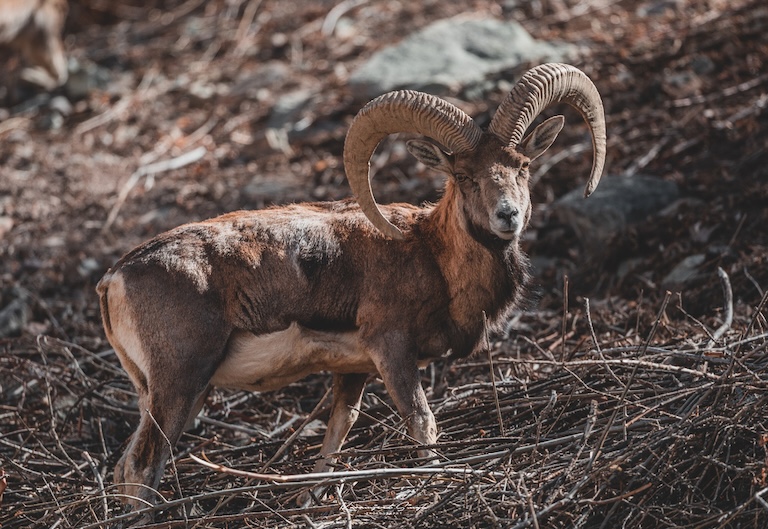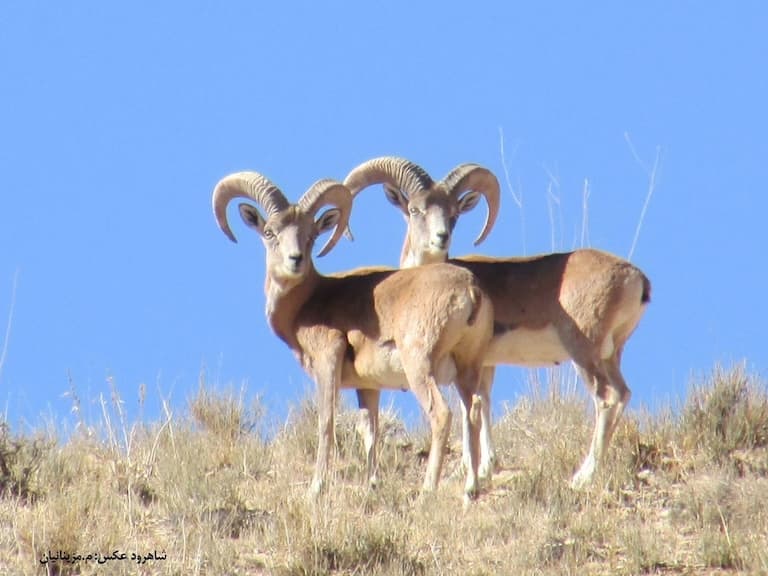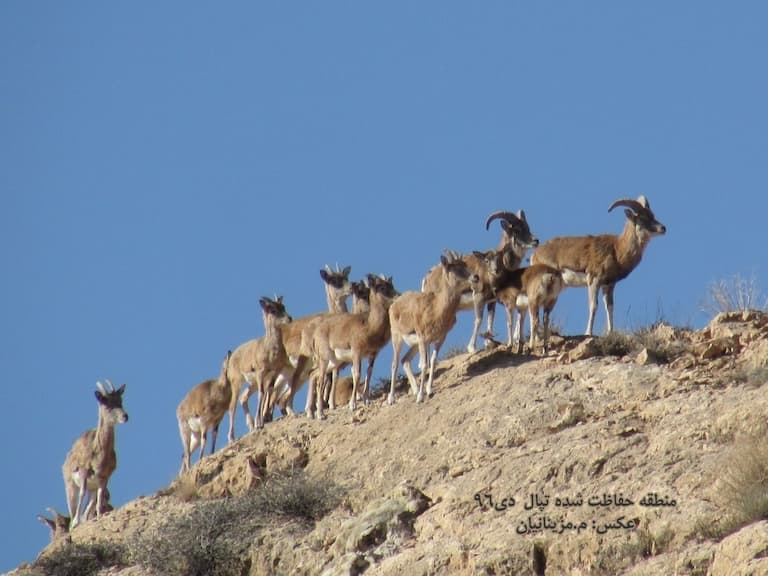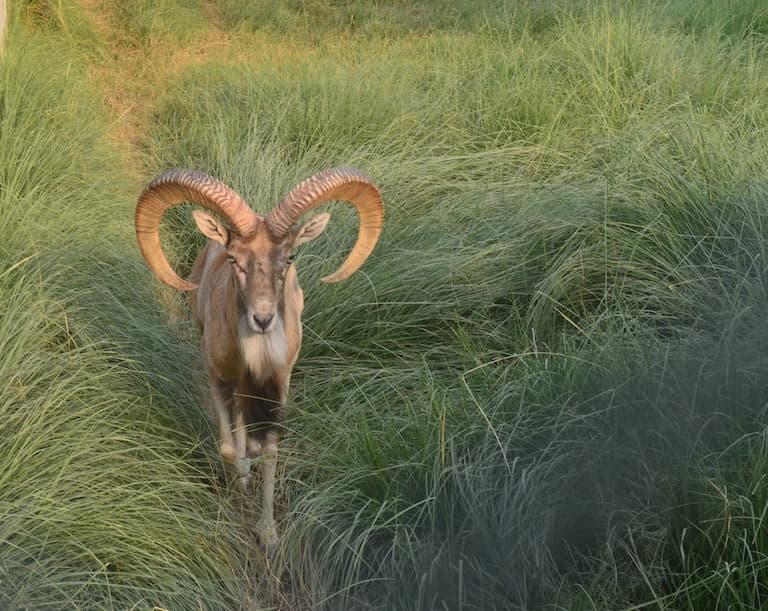Urial Profile
If you are the kind of person who doesn’t trust science and prefers to get their information from, say, a wizard; or, you’ve hit against the limitations of scientific knowledge and are considering wizardry as a last resort; you might choose to head off to Asia minor, ascend the foothills of the Himalayas, a kilometre past the treeline into the rocky, barren montane wastelands to the home range of a very dignified fellow with a long beard and wisdom in his eyes.
This is the Urial, and you’ve wasted your time, because far from imparting wisdom, this is just a sheep that can’t even talk.

Urial Facts Overview
| Habitat: | Low to high altitude, dry grasslands |
| Location: | Asia minor |
| Lifespan: | 8 to 12 years |
| Size: | Up to 1m (3 ft) tall |
| Weight: | Up to 90 kg (198 lb) |
| Colour: | Brown, with a black and white saddle and a white rump |
| Diet: | Grasses |
| Predators: | Unknown, probably raptors and leopards |
| Top Speed: | Unknown |
| No. of Species: | 1 (alternatively 3+, depending on sources) |
| Conservation Status: | Vulnerable |
Urials are a species of sheep, probably. It’s not clear, exactly, where they sit in relation to sheep and goats, but for now, they share a genus with our bleating community members on the farm. From there, we have even more uncertainty over whether the different populations are indeed the same species or distinct enough to be considered their own.
Regardless, these stunning animals are hardcore, beautiful and well worth a visit, even if they can’t teach you the way of the sword.
Interesting Urial Facts
1. What are they?
Urials don’t just look mythical; they’re also a bit of a mystery in terms of taxonomy.
The genus, Ovis (not related to the Staffordshire bread company, which begins with an apostrophe), is the Latin word for sheep. And the type species for this genus is the sheep we’re most familiar with, Ovis aries, which, is an explosion of creativity that comes from the Latin for “Sheep ram”.
But this genus, despite containing the most familiar domestic animals, is still confusing to science. For one thing, the genus Capra, the Latin word for goat, contains another ancient domesticated animal, but one which can produce fertile offspring with the domestic sheep. This is, by some definitions, enough to consider them almost the same species, let alone the same genus, and so the Ovis genus is a matter of contention between taxonomists1.
Having said that, goats and sheep are a lot more different than some of the sheep species within Ovis, including the Urials, Ovis vignei, who are considered by some to just be two versions of the same species: O. orientalis, though the latter have differing chromosomal pairs, so this seems questionable.
So, what is a Urial?
Well, the boring (and only) answer is that it’s some kind of wild sheep from Iran with an unusual number of chromosomes. Urials have 58 chromosomes, 4 more than the domestic sheep and two fewer than a goat. But even this appears to vary between populations, and hybrids occur across their range to complicate things further. So, some suggest there are actually several species of Urial, varied across the entire range.

2. They get pretty high
Whatever they are, Urials are about the most wizard-looking bovids you’ll see, and like any good wizard, they live in some remote regions that only the most committed can visit.
Urials live in the mountains (a suspiciously goat thing to do) and at some pretty chilly altitudes, of up to 4,500 metres.
They have an enormous range up there, too, with populations found all the way from Iran to India, and they specialise in regions with almost nothing to eat, which makes them even more hardcore for such a heavy animal.

3. Males are hornier than females
Females are generally smaller than males, with shorter legs and smaller horns. The males’ horns are multi-purpose, and function as an accolade of their maturity and health, as well as a genuine weapon of defence for his family.
Males routinely guard the females against bother from younger males, and the largest horns belong to the most dominant male, who has the primary breeding rights over the females.
Older males are inherently less aggressive than younger males, but they’re also stronger and more experienced, so they act as a powerful stabiliser in sheep society2.
And what horns! The largest on record were just shy of a metre in length!
4. They have few predators
Living so high up and away from almost everything else is a remarkable feat, and a tough one. But the perks are enormous. Few predators large enough to tackle a Urial are tough enough to survive up there, so these animals tend to have little other than the climatic conditions to worry about.
Still, there are jackals, eagles and probably snow leopards/regular leopards that could pose a threat. The literature is lacking in this information on account of all the aforementioned inhospitality of the region.

5. But humans are a problem
As hostile as this environment is to humans, we have still managed to screw it up. The Urial is now listed as vulnerable, and its populations are clearly decreasing, whether you consider one species or many.
Wild sheep and goats are now competing against their domestic counterparts in the same regions, and the glorious horns of the Urial have made them a target for materialistic losers with guns who like to hang body parts above their mantle to feel better about their lack of personality.
Some populations were down to as few as 2000 in 1999, which, in a worryingly out-of-date assessment, and research done in 2019, supports the idea that poaching is the single biggest threat to the species. Other concerns are around diseases spread by livestock, so, all in all, we are not treating this epic wizard sheep with the respect it has clearly earned3.
Urial Fact-File Summary
Scientific Classification
| Kingdom: | Animalia |
| Phylum: | Chordata |
| Class: | Mammalia |
| Order: | Artiodactyla |
| Family: | Bovidae |
| Genus: | Ovis |
| Species Name: | O. vignei |
Fact Sources & References
- (2025), “Afghan Urial (Ovis cycloceros)”, Ralfs’ Wildlife and Wild Places..
- Hagen (2003), “Ovis aries vignei”, Animal Diversity Web.
- Ghoddousi (2020), “Ovis vignei”, The IUCN Red List of Threatened Species 2020.
